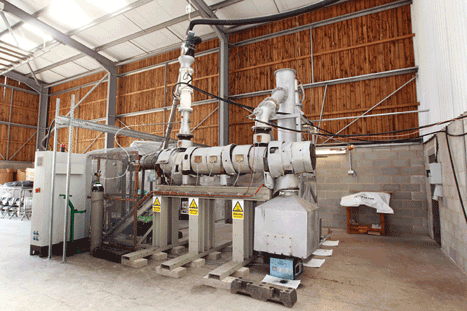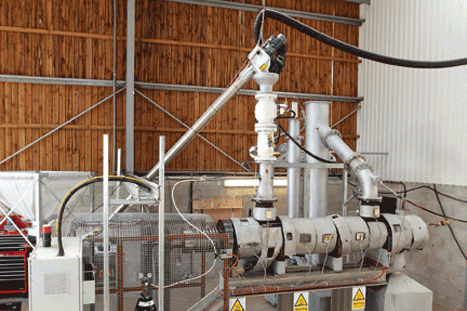Ambitious targets on waste reduction, fuelled by fears that the UK could run out of landfill sites by 2020, are driving research into a host of so-called waste-to-energy technologies that could divert rubbish away from landfill and make a meaningful contribution to the UK’s energy mix.
One such system — a form of pyrolysis technology that can be used to generate heat and power from a variety of waste products -— is currently being developed by engineers at Aston University.
Developed at Aston’s European Bioenergy Research Institute (EBRI), the system, known as the Pyroformer, has been designed to treat a range of organic waste products to generate cost-effective heat and power.
Currently undergoing tests at Harper Adams University in Shropshire, the Pyroformer will be installed at EBRI’s new £16.5m laboratory later in the year.
EBRI project manager Tim Miller told The Engineer that it will be used to power the new building and part of the Aston campus by feeding its vapour stream to a gasifier that will then feed combined heat and power (CHP) engines. His colleague Prof Andreas Hornung, head of EBRI, added that the patented system will act as an industry showcase for the technology, an educational site for students and a training site for engineers and technicians. ‘Our mission is to be the nucleus — the hub — for that whole development in Britain,’ said Hornung.

Pyrolysis is a multi-step process that involves the chemical decomposition of organic materials by heat in the absence of oxygen. Carried out at temperatures of more than 400°C, the process transforms the material into small quantities of liquid; a solid residue containing fixed carbon and ash; and combustible gases, including carbon monoxide, hydrogen and methane, among other hydrocarbons.
Cooled off-gases condense to form an oil/tar residue, and further treatment of pyrolysis gases can take place in a secondary combustion chamber, with remaining particulates filtered or scrubbed.
Unlike some earlier systems, EBRI’s technology combines the multiple steps normally associated with the process into just one, which Miller said increases efficiency and reduces the footprint of the equipment.
The coaxial conveyor screw reactor draws pellets or briquettes of combustible materials through it at temperatures ranging from 300ºC to 550ºC depending on the feedstock, producing a stream of hot vapour that contains oil, gas and water fractions.
‘It operates at a lower temperature than other pyrolysis devices and it also has an integral chemical reforming process that utilises some of the wastes that it processes as fuel and as a catalyst for some of the processes that occur in it,’ said Miller. ‘The output from the Pyroformer can be connected to a number of different devices and processes. In some instances that EBRI has taken forward and tested, the output can be condensed into pyrolysis oils.’

Working with the Indian Institute of Technology in Delhi, EBRI produced pyrolysis oil from agricultural waste that is usually burnt. The 30–40 per cent pyrolysis oil to 60–70 per cent diesel blend was then used to run generators and fuel pumps.
‘It also has very beneficial outputs from the point of view of being able to produce biochar, which is of particularly good quality; it actually produces char with a stable carbon element that can be sequestered in the earth as a soil conditioner,’ added Miller. ‘It improves plant growth and locks carbon in the earth for 1,000 years.’
Miller added that the char can be used as a fuel for cooking, further reducing deforestation.
The work going on in India is at a small scale and Hornung said that the market price for the system installed there is £40,000 for 5kWe (kilowatt electric), including the engine, the Pyroformer and the containerised system.
The unit installed at Harper Adams is intended to test and demonstrate the system on an industrial scale. ‘This is a 100kg/hr Pyroformer,’ said Miller. It has with it a CHP engine that is able to generate 0.4MWe (megawatt electric) output from waste materials.
A waste material being tested at Harper Adams is a byproduct of its own anaerobic digestion (AD) system that is used to provide power. The university also uses food and animal waste plus manure to create the gas required for the AD system, but the process leaves a residue that is inert and regarded as problematic.
‘We’re taking that residue material — the cake from the AD — and utilising it as fuel for the Pyroformer,’ said Miller. ‘The cake acts as the fuel; it produces gas oil, which generates power through the CHP engine, and it also produces char.’
Miller added that the EBRI pyrolysis system is sealed so there are no emissions; the only emissions occur through the exhaust of the CHP engines and there’s no smoke stack, unlike other incinerators. Another advantage is that it is largely free of tars and particulate matter.
‘What usually happens with pyrolysis is you get a stream of material coming out of the process that contains a lot of tar that clogs up the gasifier, which reduces the overall efficiency of the process,’ said Miller. ‘Because we have a clean jet of vapours, we can run a gasifier very effectively.’
The current system can accept most combustible items — green waste, woody materials and food residues — as long as they can be pre-processed to the right-sized pellets or briquettes.
EBRI soon plans to introduce feedstocks such as plastics, spent oil or contaminated bio oil into a new system called the Bio Activated Fuel (BAF) reactor, which would take the output from the Pyroformer and, for example, break down plastics to release their oil, which can be used to drive engines. ‘That is another patented Aston/EBRI device that will increase the percentage of oils from this whole process,’ said Miller. ‘We’ve also been looking at industrial residues — the sort of residues that are combustible but certainly wouldn’t produce a byproduct you’d want to put on a field. However, you can co-fire the char at a coal-fired power station if you don’t use it agriculturally.’
In the interim, Miller and Hornung believe sewage sludge — which has similar properties to AD sludge — could be used to help the city of Birmingham power itself from its own waste.
‘This is what we’re really working to do to test,’ said Miller. ‘Because we’ve got these industrial demonstrators, we think that the output from these units can be scaled up to between 5MW and 10MW. We’re not going to get a Drax power station out of this, but what we can do is strategically arrange the units around a city such as Birmingham and position them to accept and deal with different forms of waste and residues to develop decentralised power in a ring around the city.’
Hornung added: ‘Birmingham City Council could go 100 per cent green if it had 75MWe electric installed: 15 units. In a thermal belt around Birmingham, this would consume just the waste from sewage sludge. There is the feedstock to generate 75MWe, and that would save £25m every year from the council’s budget.’
EBRI is now keen for engineering companies to come forward and learn how the system can benefit them. ‘We’re looking for five sites in the West Midlands to do studies with companies,’ said Miller. ‘There, we can do an evaluation of the feasibility of utilising this source of technology to help them generate power and deal with their waste. If waste is being used for power, then you don’t need to pay to landfill it.’
In-depth
DECC report states that biomass will contribute to the 2020 Renewable Energy Directive targets
A report published in April 2012 suggested that biomass will be a major contributor to the delivery of the 2020 Renewable Energy Directive targets for electricity, and particularly for heat and transport fuels.
Commissioned by the Department of Energy and Climate Change (DECC), the report by bioeconomy consultant NNFCC, said that employment potential in the bioenergy sector is expected to exceed that in other renewable energy technologies as a result of the additional element of feedstock production, supply, handling and logistics.
The study found that if bioenergy deployment reached the levels predicted in the Renewables Roadmap, then there may be somewhere in the region of 35,000–50,000 UK jobs in bioenergy by 2020.
The majority of jobs are likely to be technical roles, primarily in the engineering and construction sectors, required during both the construction and operation phases of new bioenergy plant.
DECC itself said that, since April 2011, industry has announced, planned and confirmed investments totalling at least £1.6bn for biomass technologies.
The expansion of biomass heat in off-gas-grid areas of the UK will mean a growing order book for specialist boiler manufacturers and demand for new local businesses to provide installation and maintenance, and will create opportunities across the biomass production and distribution chain.

April 1886: the Brunkebergs tunnel
First ever example of a ground source heat pump?